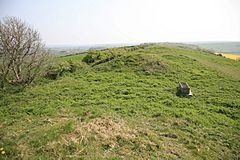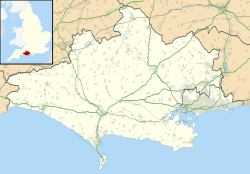Five Marys facts for kids

Looking east along the line of barrows
|
|
| Location | near Chaldon Herring, Dorset |
|---|---|
| Coordinates | 50°39′25.6″N 2°17′53.2″W / 50.657111°N 2.298111°W |
| Type | Round barrows |
| History | |
| Periods | Bronze Age |
| Site notes | |
| Excavation dates | 19th century |
| Archaeologists | Duchess of Berry |
| Designated | 27 February 1957 |
| Reference no. | 1013344 |
The Five Marys is a group of ancient burial mounds from the Bronze Age. These mounds are located near the village of Chaldon Herring in Dorset, England. The site is protected as a scheduled monument, which means it's an important historical place.
Contents
What are the Five Marys?
The Five Marys are a line of round barrows. A barrow is a mound of earth built over a burial site. These barrows sit on a ridge that goes from west to east. From this ridge, you can look down towards Chaldon Herring to the south.
In an old map from 1765, they were called "Five Meers." The word "meers" meant boundary points. This suggests they might have marked important places long ago.
Types of Mounds
Archaeologists have found different types of mounds here. There are two bowl barrows, which are simple, bowl-shaped mounds. There are also several bell barrows, which have a flat area around the base before the mound rises.
One very old mound, called a pond barrow, was once thought to be here. However, it is no longer easy to see. The largest mound is about 3.3 meters (11 feet) tall. Most of these ancient mounds have been disturbed by people digging them up a long time ago. This kind of digging is called "antiquarian excavation."
Who Explored the Mounds?
Two of the Five Marys mounds were dug up before 1866. This work was done by the Duchess of Berry. She was a French royal who was staying at Lulworth Castle nearby. She was interested in history and archaeology.
Discoveries Inside the Mounds
The two mounds she explored are believed to be the first and third large mounds from the west end. Inside each, a deep grave was found cut into the chalk ground.
Each grave held a male skeleton sitting upright. Interestingly, stag antlers were placed over each of their shoulders. One of the mounds also contained a female skeleton with similar stag antlers. The other mound had a secondary burial, which was a cremation (burnt remains) placed inside an urn (a special pot).


